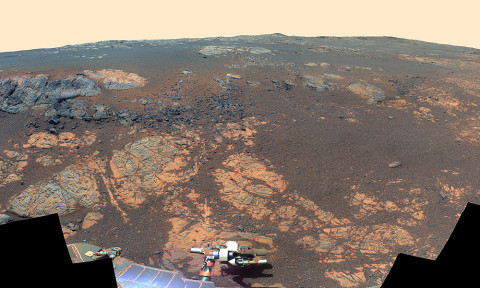Written by Guy Webster
NASA’s Jet Propulsion Laboratory
 Pasadena, CA – NASA’s Mars Exploration Rover Opportunity, one of the twin rovers that bounced to airbag-cushioned safe landings on Mars nine years ago this week, is currently examining veined rocks on the rim of an ancient crater.
Pasadena, CA – NASA’s Mars Exploration Rover Opportunity, one of the twin rovers that bounced to airbag-cushioned safe landings on Mars nine years ago this week, is currently examining veined rocks on the rim of an ancient crater.
Opportunity has driven 22.03 miles (35.46 kilometers) since it landed in the Meridiani Planum region of Mars on January 24th, 2004, PST (January 25th, Universal Time).

Since then, the mission’s team at NASA’s Jet Propulsion Laboratory, Pasadena, CA, has driven Opportunity across the plains of Meridiani to successively larger craters for access to material naturally exposed from deeper, older layers of Martian history.
Opportunity has operated on Mars 36 times longer than the three months planned as its prime mission.

“What’s most important is not how long it has lasted or even how far it has driven, but how much exploration and scientific discovery Opportunity has accomplished,” said JPL’s John Callas, manager of NASA’s Mars Exploration Rover Project. The project has included both Opportunity and its twin, Spirit, which ceased operations in 2010.
Timed with the anniversary of the landing, the rover team has prepared a color panorama of the Matijevic Hill area.
The image is online at: http://photojournal.jpl.nasa.gov/catalog/pia16703 .
JPL, a division of the California Institute of Technology in Pasadena, manages the Mars Exploration Rover Project for NASA’s Science Mission Directorate, Washington. JPL also manages the Mars Science Laboratory Project and its rover, Curiosity.
For more information about Opportunity, visit http://www.nasa.gov/rovers and http://marsrovers.jpl.nasa.gov . You can follow the project on Twitter and on Facebook at: http://twitter.com/MarsRovers and http://www.facebook.com/mars.rovers .


